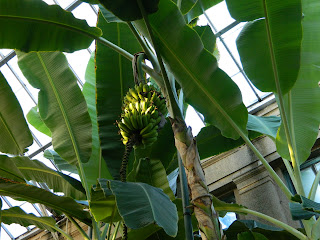Plant of the Day: Musa spp.
 | ||
| Banana tree in the west conservatory. |
I wanted to highlight bananas in this blog post because they are such fascinating plants. Despite the fact that we all refer to them as banana trees, they have no woody parts, and the 'stem' (called a pseudostem) is actually just the base of the huge leaf stalks. Each shoot of a banana has a terminal inflorescence, which means the shoot grows up, flowers, fruits, and dies. Somewhere in the middle of the growing and the dying, a new shoot (or pup) is produced from the mother leader stem. Once the leader stem produces its fruit, it must be cut back to the ground so the plant can use all its energy for growing the pup into the new leader stem. This cycle continues as long as the corm (swollen underground plant stem that serves as a storage organ) remains alive. Since the hybridized bananas we buy from the store are seedless and therefore sterile, throwing up pups is the plant's way of reproducing. Fertile bananas growing in the wild can have seeds up to the size and consistency of a golfball and reproduce through pollination.
No comments:
Post a Comment